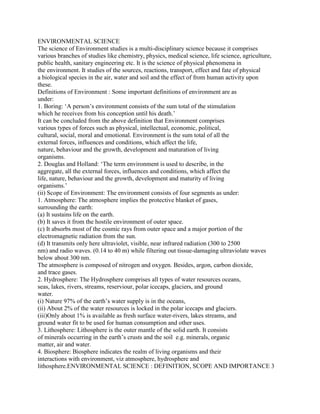
Environmental science
- 1. ENVIRONMENTAL SCIENCE The science of Environment studies is a multi-disciplinary science because it comprises various branches of studies like chemistry, physics, medical science, life science, agriculture, public health, sanitary engineering etc. It is the science of physical phenomena in the environment. It studies of the sources, reactions, transport, effect and fate of physical a biological species in the air, water and soil and the effect of from human activity upon these. Definitions of Environment : Some important definitions of environment are as under: 1. Boring: ‘A person’s environment consists of the sum total of the stimulation which he receives from his conception until his death.’ It can be concluded from the above definition that Environment comprises various types of forces such as physical, intellectual, economic, political, cultural, social, moral and emotional. Environment is the sum total of all the external forces, influences and conditions, which affect the life, nature, behaviour and the growth, development and maturation of living organisms. 2. Douglas and Holland: ‘The term environment is used to describe, in the aggregate, all the external forces, influences and conditions, which affect the life, nature, behaviour and the growth, development and maturity of living organisms.’ (ii) Scope of Environment: The environment consists of four segments as under: 1. Atmosphere: The atmosphere implies the protective blanket of gases, surrounding the earth: (a) It sustains life on the earth. (b) It saves it from the hostile environment of outer space. (c) It absorbs most of the cosmic rays from outer space and a major portion of the electromagnetic radiation from the sun. (d) It transmits only here ultraviolet, visible, near infrared radiation (300 to 2500 nm) and radio waves. (0.14 to 40 m) while filtering out tissue-damaging ultraviolate waves below about 300 nm. The atmosphere is composed of nitrogen and oxygen. Besides, argon, carbon dioxide, and trace gases. 2. Hydrosphere: The Hydrosphere comprises all types of water resources oceans, seas, lakes, rivers, streams, reserviour, polar icecaps, glaciers, and ground water. (i) Nature 97% of the earth’s water supply is in the oceans, (ii) About 2% of the water resources is locked in the polar icecaps and glaciers. (iii)Only about 1% is available as fresh surface water-rivers, lakes streams, and ground water fit to be used for human consumption and other uses. 3. Lithosphere: Lithosphere is the outer mantle of the solid earth. It consists of minerals occurring in the earth’s crusts and the soil e.g. minerals, organic matter, air and water. 4. Biosphere: Biosphere indicates the realm of living organisms and their interactions with environment, viz atmosphere, hydrosphere and lithosphere.ENVIRONMENTAL SCIENCE : DEFINITION, SCOPE AND IMPORTANCE 3
- 2. Element of Environment Environment is constituted by the interacting systems of physical, biological and cultural elements inter-related in various ways, individually as well as collectively. These elements may be explained as under: (1) Physical elements Physical elements are as space, landforms, water bodies, climate soils, rocks and minerals. They determine the variable character of the human habitat, its opportunities as well as limitations. (2) Biological elements Biological elements such as plants, animals, microorganisms and men constitute the biosphere. (3) Cultural elements Cultural elements such as economic, social and political elements are essentially man made features, which make cultural milieu.
